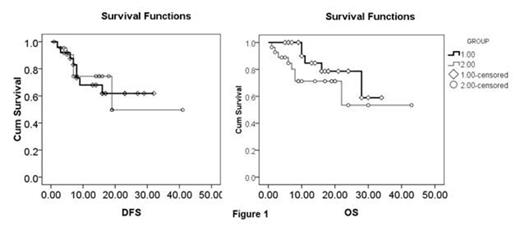Abstract
Acute myeloid leukemia (AML) of older patients is an aggressive malignancy. Despite decitabine is performed some clinic trials in these patients, however there is little data on efficacy and is more controversial on it. Recent years, our novel microtransplantation (MST) clinical studies that regular chemotherapy combined with granulocyte colony-stimulating factor mobilized peripheral blood stem cells infusion of HLA mismatched related donor(GPBSC), without using any immunosuppressive agents, which support hematopoietic recovery, perform GVL effects and improve survival without GVHD appearance in elder patients with AML. Thus, we designed an open-label control clinical trial to compare the efficacy of decitabine plus MST to only MST for elder AML.
The 61 patients in the registry were randomly assigned into two groups, 30 patients were in decitabine plus cytarabine/anthracycline (DCA) group, 31patients were in cytarabine/anthracycline (CA) group. In DCA group induction therapy included decitabine 30mg/m2/days1-4, cytarabine 100 mg/m2/days 1-7 and daunorubicin 45 mg/m2 days 1-3, or idarubicin 12 mg/m2 days 1-3, or mitoxantrone 10 mg/m2 days 1-3, or aclarubicin 10mg /m2 days 1-7 followed by intravenous infusion of GPBSC 24h after cytarabine therapy. Patients achieving CR received 2 further courses of post-remission therapy with decitabine (30 mg/m2 daily for 4 days) and medium-dose cytarabine therapy (cytarabine, 1-2 g/m2 , per 12 h intravenously, 3 hours infusion on days 1, 2, and 3) followed by infusion of GPBSC 24h after each cycle of cytarabine chemotherapy. Except for decitabine other treatments is same in CA group.
The complete remission rate (CR) of patients in DCA group was lower than that of patients in CA group (70.0% vs.80.6 %, p=0.38). There was no statistical difference in CR rate in two groups. The median overall survival (OS) and diseases-free survival (DFS) in DCA group were not differences than those in the CA group (DFS, 26.5vs. 22.8months, p = 0.90; OS, 28.4months vs. 28.1months, p = 0.19,figure 1). The median duration of neutropenia was longer in the DCA group than in the CA group (14 vs. 10 days, p = 0.02). The median duration of thrombocytopenia was longer in the DCA group than in the CA group (16 vs. 14 days, p = 0.32).The rate of severe infection and TRM were not differences in two groups.
This study suggests MST therapy results in a 71.4% CR in patients ≥60 years old a 21months DFS with acceptable toxicity. The decitabine did not produce superior outcomes than cytarabine and anthracyclines treatment, and resulted in prolonged suppression of bone marrow. Further studies involving a larger cohort of patients and longer follow-up are warranted.
The probabilities of OS and PFS in the DCA group compared with CA groups. 1 thin line, DCA group; 2 thick line, CA group. DFS, 26.5vs. 22.8months, p = 0.90; OS, 28.4months vs. 28.1months, p = 0.19. The 12-month progression-free survival (PFS) for the MDS group and tAML group was 62.3% and 43.7%, respectively. The 24-month DFS for the DCA group and CA group was49.6% and 61.8%, respectively.
The probabilities of OS and PFS in the DCA group compared with CA groups. 1 thin line, DCA group; 2 thick line, CA group. DFS, 26.5vs. 22.8months, p = 0.90; OS, 28.4months vs. 28.1months, p = 0.19. The 12-month progression-free survival (PFS) for the MDS group and tAML group was 62.3% and 43.7%, respectively. The 24-month DFS for the DCA group and CA group was49.6% and 61.8%, respectively.
No relevant conflicts of interest to declare.
Author notes
Asterisk with author names denotes non-ASH members.


This feature is available to Subscribers Only
Sign In or Create an Account Close Modal